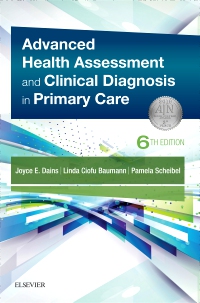
Advanced Health Assessment & Clinical Diagnosis in Primary Care - Elsevier eBook on VitalSource, 6th Edition
Elsevier eBook on VitalSource

Now $87.39
Awarded second place in the 2019 AJN Book of the Year Awards in the Adult Primary Care category. Learn to accurately diagnose the majority of patients seen in today’s primary care settings! Advanced Health Assessment and Clinical Diagnosis in Primary Care, 6th Edition goes beyond basic history and physical examination skills to help you learn the diagnostic reasoning process. You will develop this key skill by following assessment guidelines that focus on a specific complaint rather than beginning with a previously established diagnosis or disease entity. Written by advanced practitioners, this edition includes a new chapter on The Transgender Patient that gives you the knowledge you need to properly assess and care for this underserved patient population. It also features expanded coverage of geriatrics, highly infectious diseases, coordination with the interprofessional healthcare team, genetics/genomics in lab testing and family history, updates on psychiatric-mental health problems, and more!
Newer Edition Available
Advanced Health Assessment & Clinical Diagnosis in Primary Care - Elsevier E-Book on VitalSource
-
- A clear, consistent diagnostic reasoning process takes you to the next step of health assessment -- beyond basic history and physical examination to diagnostic reasoning
- Diagnostic Reasoning: Focused History sections use "self-questions" to walk you through the thinking process involved in obtaining a pertinent, relevant, problem-specific history that will assist in differential diagnosis
- Diagnostic Reasoning: Focused Physical Examination sections explain how to perform more advanced diagnostic techniques and interpret the findings
- Key Questions guide you through assessment and toward an accurate diagnosis by listing questions to ask the patient, followed by explanations of what the patient's responses might signify
- Laboratory and Diagnostic Studies sections outline the types of tests that might be appropriate based on the focused history and focused physical examination
- Differential Diagnosis sections offer the most common diagnoses for each patient problem and summarize the history and physical examination findings, along with recommended laboratory and diagnostic studies
- Differential Diagnosis tables provide you with a quick-reference summary of possible diagnoses for each patient problem
- Evidence-Based Practice boxes -- more than 30 NEW -- summarize the scientific evidence related to the diagnosis of patient problems
- Evidence-Based Preventive Health Screening chapter helps you to screen for common asymptomatic conditions and promote wellness
- Information on screening for abuse and sexual assault helps you identify patients who might need additional support or intervention
- List of Chapters by Body System provides a convenient Table of Contents organized by body system
-
- NEW! Updated content throughout, includes a special focus on genetics/genomics, psychiatric-mental health issues, geriatrics, and more
- NEW! Chapter on The Transgender Patient equips providers with the necessary knowledge to properly assess and care for this underserved patient population
- NEW! Interprofessional team of reviewers ensures that content is appropriate for Nurse Practitioners, Physician Assistants, Respiratory Therapists, and other providers, as well as ensuring that referral information promotes effective interprofessional collaboration
- NEW! A smaller, more convenient size makes it easy to have this this essential reference handy in a lab-coat pocket, and expanded color illustrations and full-color design enhance content, with colored thumb tabs making it easier for you to find the information you need
- NEW! Updated information on psychiatric/mental health problems reflects the latest changes in practice as well as changes to the DSM
-
PART I: AN INTRODUCTION TO CLINICAL REASONING
1. Clinical Reasoning, Differential Diagnosis, Evidence-Based Practice, and Symptom Analysis
2. Evidence-Based Health Screening
PART II: COMMON SYMPTOMS IN PRIMARY CARE
3. Abdominal Pain
4. Affective Changes
5. Amenorrhea
6. Breast Lumps and Nipple Discharge
7. Breast Pain
8. Chest Pain
9. Confusion in Older Adults
10. Constipation
11. Cough
12. Diarrhea
13. Dizziness
14. Dyspnea
15. Earache
16. Fatigue
17. Fever
18. Genitourinary Problems in Males
19. Headache
20. Heartburn and Indigestion
21. Hoarseness
22. Lower Extremity Limb Pain
23. Upper Extremity Limb Pain
24. Low Back Pain (Acute)
25. Nasal Symptoms and Sinus Congestion
26. Palpitations
27. Penile Discharge
28. Rashes and Skin Lesions
29. Rectal Pain, Itching, and Bleeding
30. Red Eye
31. Sleep Problems
32. Sore Throat
33. Syncope
34. Urinary Incontinence
35. Urinary Problems in Females and Children
36. Vaginal Bleeding
37. Vaginal Discharge and Itching
38. Vision Loss
39. Weight Loss/Gain (Unintentional)
PART III: DIAGNOSTIC IMAGING
40. The Abdominal X-Ray
41. The Chest X-Ray
Part IV: SPECIAL CONSIDERATIONS
42. The Transgender Patient



 as described in our
as described in our 